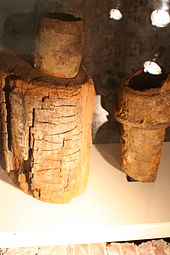User:Jeffrd10/sandbox
Materials[edit]

Metal[edit]
Pipes made from metal are the first pipes that were created, with copper piping dating back to the Indus river valley civilization around 5,000 B.C. Metal piping was used extensively before the advent of plastic piping with metal piping almost used exclusively[1]. In modern plumbing metallic piping is still used extensively both in industrial and Residential Settings. Pipes made out of metal are joined By welding, soldering, Or mechanical joining (threaded pipes, flange construction, etc)[2]
Lead[edit]
Lead piping was used extensively in early plumbing systems and saw continued use for most of plumbing history due to its abundance and usability. The Ancient Romans where among the first to use lead piping and set the standard for lead plumbing [3]. The use of lead piping for water supply continued well into the 19th and 20th century with 70% of cities in the United states using lead water lines.[4] The usage of lead for plumbing died out after the 1930 due to knowledge of leads health effect. Lead is still present in plumbing mostly in older plumbing systems however is no longer installed routinely.[5]
Copper[edit]
Copper piping and tubing have seen over 5,000 years of plumbing use[6]. In modern plumbing copper piping and tubing are the most widely used pipe in the world.[7]. Due to its versatility and strength Copper tubing is commonly used in HVAC as a refrigerant conduct.[8] The use of copper piping is diminishing in residential settings due to competition from plastic tubing however copper still remains the most used pipe for water delivery.[9]
Cast Iron[edit]
Cast iron piping is a newer type of metal pipe with the first recorded use of cast iron pipes being in 16th century germany. The use of cast iron was rare until smelting became cost effective in 1738[10]. Cast iron is mostly used for underground sewers and water distribution due to its long lasting nature. The use of cast iron has dramatically diminished due to increased usage of plastic drain piping.[11][12]
Plastic[edit]
The Development of plastic piping began in Germany,in 1912, with the advent of the synthetic plastic polyvinyl chloride. Germany was the first country to use plastic piping however this remained in the small scale due to the constraints of plastic manufacturing.[13]. After World War II plastic piping was used extensively in the reconstruction of Germany and Japan. This spurred Development of plastic piping and caused plastic to become a viable alternative to metal piping[14]. Plastic Piping is used in residential and industrial setting and most new construction uses plastic piping significantly more then piping made of metal. [15]. The joining of plastic pipe is done by solvent welding or mechanically joining the pipe.[2]
- ^ "27 Historical Events that Shaped Modern Plumbing Systems". Ivey. Retrieved 2016-03-15.
- ^ a b Muscroft, Steve (2016-03-14). Plumbing. Elsevier. Cite error: The named reference "Plumbing" was defined multiple times with different content (see the help page).
- ^ Stilo, Aleius. "Lead Poisoning and Rome". Encyclopedia Romana. University of Chicago. Retrieved 2016-03-16.
- ^ "The Significance of Lead Water Mains in American" (PDF). University of Pittsburgh. Retrieved 2016-03-16.
- ^ Rabin, Richerd (2008-08-09). "The Lead Industry and Lead Water Pipes "A MODEST CAMPAIGN"". Retrieved 2016-03-16.
- ^ "Copper:An Ancient Metal". Dartmouth Toxic Metals. Dartmouth University. Retrieved 2016-03-16.
- ^ Henkenius, Merne (2002). Plumbing:Basic, Intermediate & Advanced Projects. ISBN 1-58011-085-1.
- ^ Trethewey, Richard (1994). This Old House:Heating, Ventilation, and Air Conditioning. Little, Brown and Company. ISBN 0-316-85271-6.
- ^ Cauldwell, Rex (2009). Plumbing Complete. The Taunton Press. ISBN 978-1-56158-855-8.
- ^ "Cast Iron Soil Pipe and Fitting hand book" (PDF). Charlottepipe. 2006. p. 15. Retrieved 2016-03-16.
- ^ Chace, Pete. "Whats the Delay With the needed Replacement of old Pipe?" (PDF). Retrieved 2016-03-16.
- ^ Christensen, Ryan (2009-12-01). "Age Effects on Iron Based Pipes in Water Distribution Systems". Utah state University. Retrieved 2016-03-16.
- ^ Walker, Robert (1990). "The Early History of PVC Pipe" (PDF). Uni-Bell PVC Pipe news: 1–2. Retrieved 8 March 2016.
- ^ Blankenbaker, Keith. Modern Plumbing. Goodheart Willcox. p. 574. ISBN 978-1-61960-863-4.
- ^ Walsh, Thomas (2011). Plastic Pipe and Fittings: Past Present and Future. ASTM international. ISBN 978-0-8031-7514-3.
